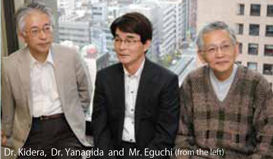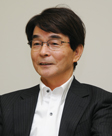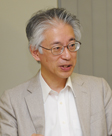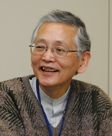 HPCI Strategic Program Field 1 Special Discussion
HPCI Strategic Program Field 1 Special Discussion
Pioneering the Future of
Computational Life Science toward
Understanding and Prediction of
Complex Life Phenomena
HPCI Strategic Program Field 1 Supercomputational Life Science

Program Director of RIKEN HPCI Program
for Computational Life Sciences
Toshio Yanagida
Deputy- Program Director of RIKEN HPCI Program
for Computational Life Sciences
Akinori Kidera
Deputy- Program Director of RIKEN HPCI Program
for Computational Life Sciences
Yukihiro Eguchi
The HPCI Strategic Program, which aims to produce the world’s best research products in a wide variety of fields by utilizing Japanese High-Performance Computing Infrastructure (HPCI) centered on K computer and returning their fruits to society, got into full swing this year. Field 1, “Supercomputational Life Science,” has four R&D themes. What are the details of the projects? How will the researchers proceed with the themes? Following the preceding issue, we had Director Toshio Yanagida, Deputy Program Director Akinori Kidera, and Deputy Program Director Yukihiro Eguchi talk about that.
●Four R&D projects

YANAGIDA(Honorifics omitted): Then, let us start by introducing themes 1 to 4 to explain what kinds of themes we are going to work with in Field 1.
KIDERA: Our goal is to use the maximum performance of the K computer and produce results that contribute to life science. For this purpose, we don’t start from scratch but in essence utilize the established “workable computation approaches.” In that sense, the four themes are roughly divided into three categories. In Theme 1, “Simulations of biomolecules under cellular environments” and Theme 2 “Simulation applicable to drug design,” we do biomolecular simulations utilizing molecular simulation techniques. In Theme 3, “Hierarchical integration simulation for predictive medicine,” fluid-structure interaction analysis incorporating fluid dynamics calculation into structure analysis is performed. In Theme 4, “Large-scale analysis for life data,” analysis of life data centered on the genome is performed. By taking a more detailed look at each theme, it is seen that the themes are not limited to those mentioned above. For example, Theme 3 includes simulation of the cerebral nervous system. In any case, we use methods that have been developed so far. For example, in biomolecule simulation f or T heme 1 and 2 , we use existing methods such as quantum chemical calculation, molecular dynamics calculation and coarse grained model calculation, which are scaled up with the K computer.
The reason why molecular simulations are divided into two themes is, as suggested by “Application in Drug Discovery and Medical Development” clearly stated in the title of Field 1, because we want to clearly express that we attach importance to contribution to drug discovery and medical development as a result of the simulation studies. In order to promote drug discovery approaches intensively as an application of molecular simulations, we defined Theme 2. Of course, we proceed not only with Theme 2 but also all themes with contribution to drug discovery and medical development in mind.
EGUCHI: A certain level of model has already been established for Theme 2. Meanwhile, not only scaling up of traditional and conventional models, but also contriving a new model, is required for Theme 1, I think. Don’t you think such a challenge is imposed on Theme 1?
KIDERA: Exactly. Theme 2 has established models. A significant result is expected through efficient use of the models. However, it is not the sole method. There is a possibility for Theme 2 to develop into something superb. In this regard, Theme 2 is still a challenge.
EGUCHI: What do you think about Theme 1?
KIDERA: What we have to do in Theme 1 is make maximum use of the K computer at the existing level of molecular dynamics models to improve the level of existing simulations. Then, perform the calculation of a large system for a longer time to replicate molecularlevel biological events that have not been observed so far or have finally been elucidated. We have to start off from there. Through such work, we should search for models for the next-generation simulation. That would be the order of things in Theme 1.
YANAGIDA: You can say life systems are a world which is made up of hyperdegrees of freedom. Until now, we have been trying to understand life systems by limiting the degree of freedom to a controllable range with various hypotheses. Of course, it is not possible that you only have to make the K computer calculate a system with hyper- degrees of freedom to get instant results. Nevertheless, we have to construct models by trial and error. When we return the model to hyperdegrees of freedom, we perform simulation with a computer and get predictions. Therefore, simulation should be used not only for explaining the phenomena observed so far but also for leading to the next prediction. That is why we have to do modeling. For this reason, it is important to combine experiments, model and simulation.
KIDERA: Actually, it is very difficult to combine modeling and prediction. The model must be predictable because we cannot move forward only by explaining previous data. For that, we should do ab initio (non-empirical) simulation in which as high a degree of freedom as possible is built in. In the results obtained, we should find phenomena that can be expressed with a new low degree of freedom and improve the model. Of course, we can use experiment itself to improve the model.
●Exploratory challenges focusing on the final goal are also important.
EGUCHI: Theme 3 is also very challenging.

KIDERA: Theme 3 is a project focusing on interaction and integration. For example, in traditional blood flow simulations, blood vessels and the heart are viewed as structure, and blood flow as fluid. In our simulation, structure and fluid are coupled together. In addition, we are going to combine heart and systemic vasculature simulators, which have been simulated separately so far. On top of that, we introduce totally different simulators such as systemic skeletal musculature and the cerebral nervous system, and link them together for doing human whole-body simulation. We also strongly emphasize medical support, and clearly set forth simulations that contribute to prediction of disease state, review of treatment method and evaluation of drug efficacy as our goal.
EGUCHI: Some researchers may doubt that integration can be achieved successfully.
YANAGIDA: However, from the standpoint of clinicians, this is one type of research they definitely want us to do. To tell the truth, I was a professor of physiology at Osaka University. In physiology, that research was so far done in a classical manner. If that research is combined with computer science and progresses further, I think it would have a great impact on medical science. Although it will be very challenging, I believe biology must aim at this. It is of course important to get results with the K computer, but it is also important to consider what our final goal is.
KIDERA: It is a fair argument that we have to define a clear-cut, achievable goal. However, there is another concept. Are we allowed to target only what would be visible by scaling up with the K computer? We want to carry out challenging trials having more heuristic elements with the K computer. We want to start research towards a real goal with the K computer. Such a desire is also very important. I believe the attempt to conduct an integrated whole-body simulation with multiscale multi-physics simulation in Theme 3 is crucial in the sense of exploratory challenges that precisely cultivate such budding ideas for the future.
●Contribution to medical treatment by life data analysis

EGUCHI: Themes 1 to 3 partially overlap one a nother, but Theme 4 is relatively distinct from the others as it handles data analysis.
YANAGIDA: Theme 4 aims to understand life programs and their diversity through large-scale analysis of life data based on the genome, and utilizing them for individualized medicine and industrial use of genome information.
KIDERA: Various new experimental technologies produce a huge amount of life information. By analyzing it, we have to understand what it means and step into the field of prediction. Theme 4 is a project using the K computer to analyze such life information. What is the most important part and one we have focused on ahead of the others is the large-scale genome information produced by the next-generation sequencer. We have to analyze life system data which is becoming larger and rapidly more refined. However, now, it is too much to handle with conventional computer resources. Therefore, we are seeking a basis to analyze life system data with the K computer. This theme is directly linked to experimental data, and we believe we can realize a data-analytical science as part of new life sciences with the K computer.
EGUCHI: Prof. Satoru Miyano, who is head of Theme 4, emphasizes that what can be explained by first-principle equations is very limited in life science, and most phenomena do not have a clear-cut first principle. I believe he thinks this way: in order to view life science as science, we have to let the data speak. That is, we have to strive to find some regularity in the huge amount of data produced. He said he wanted to focus on preparing a system that can analyze data obtained with a next-generation sequencer efficiently on the K computer for the first couple of years.
KIDERA: There is an extremely strong demand for that at least. This is one reason. In addition, if such a system does not work on the K computer sufficiently well, we would not be able to perform further large-scale life data analysis on a full scale. With the development of a sequencer, we will certainly have an increasing number of data for genome analysis.
YANAGIDA: First, we have to organize the data. Then, from this enormous amount of data, we extract meaningful information, for example information leading to prediction of a disease. For this purpose, larger computer resources are required. We can say we have to do data mining.
EGUCHI: On the other hand, in the study on cancer metastasis Prof. Miyano released recently, he found a gene suspected to be involved in metastasis through gene network analysis, and was able to demonstrate its involvement through experiments. Those approaches which are not limited to prediction will become important.
●We aim at heuristic simulations
KIDERA: We have viewed the four R&D themes one by one. Now we have to conceive the impact of K computer on whole projects. As an orthodox research and development concept in the HPCI Strategic Program, research results are required which can be obtained only by computation-scale expansion with the K computer. If we only perform very large calculations and it does not lead to the fruits of life science that were our original target, it is not the goal or result we are seeking.
YANAGIDA: Yes. If we have to continue symbolic research just to upkeep the K computer, it is exactly like putting the cart before the horse.
KIDERA: It is still difficult to say that computer science has become widespread in the field of life science. I’m sorry to say it, but there is no prototype of life science research using the K computer which is a high-end computer resource. In circumstances such as these, we should not use the K computer simply as we are told, and get results anyway. Eventually this project should be evaluated by how much genuine scientific results can be obtained. I think that is what is important.
YANAGIDA: As we said before, we have been trying to understand life systems with a hyper-degree of freedom by limiting the degree of freedom to a controllable level. It might be a good idea to put higher degrees of freedom into the K computer anyway. By doing so, the key degree of freedom may surface.
KIDERA: The K computer may make it possible to jump from a simulation without any conflicts to the area of “heuristic simulation” in which something that has not been expected is discovered in the results, right?
YANAGIDA: I like the phrase, “ heuristic simulation.” We aim at heuristic simulation in life systems with a hyper-degree of freedom. We can summarize our discussion on that note.
KIDERA: We also have to remember that we are trying to achieve it with the K computer. Something very positive is going to happen in biology. We should be thankful that we are lucky enough to witness it, and keep trying our best to reach our goal.
BioSupercomputing Newsletter Vol.6
- SPECIAL INTERVIEW
- Development of New Fluid-structure Interaction Analysis (ZZ-EFSI) Resulting in Rapid Achievement of High Operation Performance
Research Associate Professor, School of Engineering, The University of Tokyo Kazuyasu Sugiyama - Interview with High-performance Computing Team Members: Continued Efforts in Tuning to Harness the Potentials and the High Capability of the K Computer
Group Director of Computational Molecular Design Group,
Quantitative Biology Center, RIKEN
Makoto Taiji
Senior Researcher of High-performance Computing Team,
Integrated Simulation of Living Matter Group,
Computational Science Research Program, RIKEN
Yousuke Ohno
Senior Researcher of High Performance Computing Development Team,
High Performance Computing Development Group,
RIKEN HPCI Program for Computational Life Sciences
Hiroshi Koyama
Researcher of High-performance Computing Team,
Integrated Simulation of Living Matter Group,
Computational Science Research Program, RIKEN
Gen Masumoto
Research Associate of High-performance Computing Team,
Integrated Simulation of Living Matter Group,
Computational Science Research Program, RIKEN
Aki Hasegawa
- Report on Research
- Functional Analysis of Multidrug Efflux Transporter AcrB by All-Atom Molecular Dynamics Simulation
Graduate School of Nanobioscience,
Yokohama City University
Tsutomu Yamane,
Mitsunori Ikeguchi
(Molecular Scale WG) - Multi-scale Modeling of the Human Cardiovascular System
Computational Science Research Program,
RIKEN Liang Fuyou (Organ and Body Scale WG) - Toward a spiking neuron-level model of the early saccade visuomotor system
Kyoto University Jan Moren
Nara Institute of Science and Technology Tomohiro Shibata
Okinawa Institute of Science and Technology Kenji Doya
(Brain and Neural Systems WG) - Developing the MD Core Program for Large Scale Parallel Computing
Computational Science Research Program,
RIKEN Yousuke Ohno (High-performance Computing Team)
- SPECIAL INTERVIEW
- Pioneering the Future of Computational Life Science toward Understanding and Prediction of Complex Life Phenomena
Program Director of RIKEN HPCI Program for Computational Life Sciences
Toshio Yanagida
Deputy- Program Director of RIKEN HPCI Program for Computational Life Sciences
Akinori Kidera
Deputy- Program Director of RIKEN HPCI Program for Computational Life Sciences
Yukihiro Eguchi
- Report on Research
- Free Energy Profile Calculations for Changes in Nucleosome Positioning with All-Atom Model Simulations
Quantum Beam Science Directorate, Japan Atomic Energy Agency
Hidetoshi Kono, Hisashi Ishida, Yoshiteru Yonetani, Kimiyoshi Ikebe (Field 1- Program 1) - Estimation of Skeletal Muscle Activity and Neural Model of Spinal Cord Reflex
Information Science and Technology, The University of Tokyo
Yoshihiko Nakamura (Field1 - Program 3)
- Report
- ISLiM Interim Accomplishment Meeting in 2011
Computational Science Research Program, RIKEN Eietsu Tamura - Computational Life Sciences Classes Held in High Schools
HPCI Program for Computational Life Sciences, RIKEN
Chisa Kamada, Yasuhiro Fujihara, Yukihiro Eguchi
